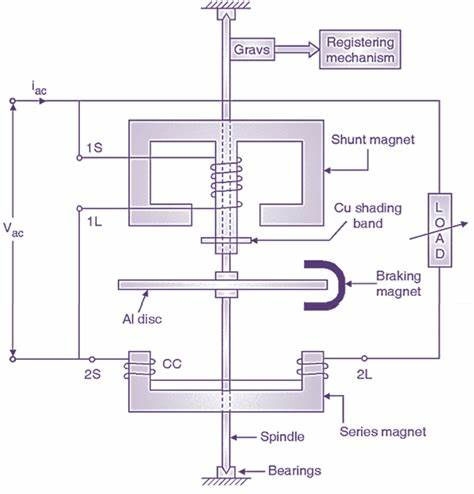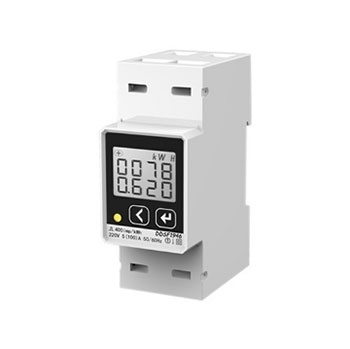An energy meter, also known as a watt-hour meter, is an instrument used to measure electrical energy consumption. It is a vital component in power systems, serving the purpose of quantifying the consumption of electrical energy and providing accurate calculations for electricity charges to users. In this article, sisco will briefly introduce energy meter to you, including its structure, working principles and applications, etc., to help you have a better understanding of it.
Structure of Energy Meter
Energy meters typically consist of three basic components: the current circuit, the voltage circuit, and the dial system.
- Current Circuit
The current circuit is divided into two parts: the current coil and the magnetic field system.
- Current Coil: Usually made of multiple layers of copper wire wound around an iron core, the current coil operates by using the current to drive the movement of the coil's magnetic field, interacting with the magnetic field system.
- Magnetic Field System: Composed primarily of a magnetic core and magnetic poles, the magnetic core is typically made of laminated silicon steel sheets to reduce magnetic flux losses. The magnetic poles control the distribution of the magnetic field within the current coil.
- Voltage Circuit
The voltage circuit also comprises two parts: the voltage coil and the circuit control system.
- Voltage Coil: Manages the operation of the energy meter and measures the voltage passing through it. The voltage coil, wound with fine copper wire, is installed on the meter's iron core.
- Circuit Control System: Mainly composed of capacitors and resistors, the circuit control system plays a crucial role in energy storage and filtering interference. Resistors are primarily used for voltage division, current limiting, and accuracy adjustment.
- Dial System
The dial system includes gears, support structures, dials, and pointers.
- Gears: Transmit the force of the motor and convert the rotational speed into a digital display format.
- Support Structures: Support the motor and gears, ensuring the compactness and integrity of the entire energy meter structure.
- Dials and Pointers: Display the measured values. Energy meters typically have two pointers on the dial, one for displaying current intensity and another for displaying voltage intensity. The pointers can be adjusted for accuracy based on the set measurement range.
Working Principles of Energy Meter
The principle of an energy meter is based on the concept of electromagnetic induction, involving the interplay of current, magnetic fields, and electromagnetism. When an electric current flows through a conductor, it generates a magnetic field around it. Conversely, when a magnetic field intersects with a conductor, it induces the generation of an electric current. This phenomenon is known as mutual induction. The measurement of current and voltage involves converting the quantity to be measured into voltage or current using inductive elements, followed by subsequent components in the circuit to achieve the measurement.
In an energy meter, when current flows through the current coil, a magnetic field is generated within the coil. This magnetic field interacts with the magnetic flux between the iron core and magnetic poles, creating a torque on the rotating axis. The voltage coil measures the voltage in the circuit. By measuring these currents and voltages, the electrical energy in the circuit can be quantified.
Traditional energy meters are typically mechanical, but modern ones often incorporate electronic components such as sensors, integrated circuits (ICs), and computer chips. Electronic energy meters are more accurate, reliable, and versatile compared to traditional mechanical meters. They can measure power factor and frequency variations in complex circuits.
Applications of Energy Meter
Energy meters play a crucial role not only in the power industry but also find extensive applications in various other sectors such as industrial production, transportation, agriculture, healthcare, and more. Below is an overview of the applications of energy meters in different fields.

- Industrial Production
In industrial production, energy meters are used to monitor the energy consumption of machinery and equipment, providing accurate data to help factory managers plan and make decisions regarding energy usage. Energy meters can also detect the operating status and load conditions of equipment, assisting factories in monitoring energy consumption, improving management efficiency, and reducing energy waste. - Transportation
In the transportation sector, energy meters can be employed to monitor the energy consumption during the charging process of electric vehicles and other transportation devices. Energy meters help vehicle owners or fleet managers understand the energy consumption of vehicles, facilitating the regulation of related vehicle maintenance and operation plans for more efficient and accurate management of vehicle energy usage. - Agriculture
In the agricultural sector, irrigation systems and crop cultivation require significant energy support. Energy meters assist farmers in managing and optimizing energy usage, monitoring energy-consuming aspects of agricultural production, providing fundamental data for energy consumption regulation, and reducing waste, contributing to the sustainable development of agricultural production. - Healthcare
Hospitals require a substantial amount of energy, including electricity for medical equipment and building usage. Energy meters can be used to monitor the energy consumption of devices during usage, aiding hospitals in resource management and the implementation of energy-saving measures.
Energy meters not only play a crucial role in the power industry but also contribute significantly to optimizing energy efficiency in various sectors. With the continuous development of new energy and smart technologies, the functionality and performance of energy meters are expected to become more robust, playing an increasingly important role in energy management and applications.

